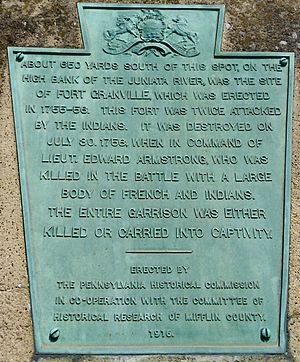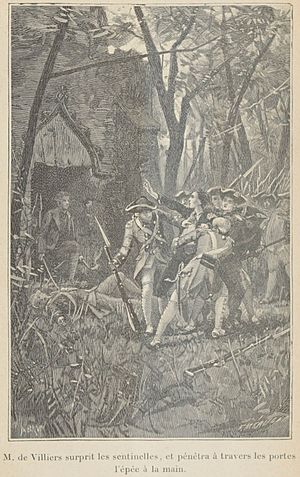Fort Granville facts for kids
Quick facts for kids Fort Granville |
|
|---|---|

1916 state historical marker near Lewistown
|
|
| Location | Mifflin County, Pennsylvania |
| Built | 1756 |
| Lua error in Module:Location_map at line 420: attempt to index field 'wikibase' (a nil value). | |
Fort Granville was a small fort built by soldiers in the old Province of Pennsylvania. It was located about a mile from Lewistown, in what is now Mifflin County. From 1755 to 1756, this fort protected early settlers in the Juniata River valley during the French and Indian War.
Contents
Why Fort Granville Was Built
After a big battle in 1755, English settlers in Pennsylvania faced attacks from French and Native American groups. These groups, including the Shawanese and Delawares, became more daring in their raids. To keep people safe, the government decided to build a line of forts across Pennsylvania.
On December 17, 1755, Captain George Croghan received an important order. This order, signed by Benjamin Franklin and others, told him to build three forts. Each fort needed to be 50 feet square with strong blockhouses at two corners. They also needed barracks inside to house 50 soldiers.
Where Fort Granville Was Located
Captain Croghan chose a spot for Fort Granville near a spring along the Juniata River. This was different from the original plan to build it at the mouth of the Kishacoquillas Creek.
Today, the exact spot of the fort is hard to find. The building of the Pennsylvania Canal around 1829 changed the area. Historians say this fort was a key part of the forts west of the Susquehanna River. It was important because it guarded where the Juniata River flows through the mountains.
Fort Granville's Military Role
By the summer of 1756, settlers living near Fort Granville rarely left its safety. This was because they saw more and more hostile Native Americans in the area. Lieutenant Armstrong arrived with soldiers to help protect the settlers during harvest time. Some of these soldiers were sent to help other settlers further south.
Around July 22, about 60 to 70 warriors appeared outside the fort. They were ready for a fight. The fort's commander decided not to attack, hoping they would leave. The attackers shot one man, but he managed to get back inside the fort without serious injury. A short distance away, they attacked a man named Baskins, burned his house, and took his family. They also captured Hugh Carrol and his family.
The Attack on Fort Granville
On July 30, Captain Edward Ward, who was in charge of Fort Granville, left the fort. He took most of the soldiers, leaving only 24 men with Lieutenant Edward Armstrong in command. Captain Ward went to protect settlers in another valley.
The attackers learned how few men were left at the fort. On August 2, about 100 Native Americans and 55 French soldiers attacked. They were led by Francois Coulon de Villiers. Even with only 24 men, Lieutenant Armstrong and his soldiers fought bravely. They held off the attackers until the next morning.
Around midnight, Coulon's men managed to set Fort Granville on fire. Lieutenant Armstrong was shot while trying to put out the fire. The French commander offered a chance for the defenders to surrender. However, Armstrong refused to give up. He was shot a second time and sadly died.
After Armstrong's death, Sergeant John Turner surrendered the fort. This meant the soldiers and civilians inside became captives. Sadly, Sergeant Turner was also killed. The captives were taken far away to a place called Fort de Chartres. There, French officers helped them by paying for their freedom from the Native Americans. They were then taken to New Orleans and eventually returned to the American colonies.
After the attack, the French commander ordered Captain Jacobs, a leader of the Delaware participants, to burn Fort Granville. This attack led to a strong response from the English. Lieutenant Armstrong's brother, John Armstrong, led a group of soldiers on a mission called the Kittanning Expedition to get revenge.
Images for kids



